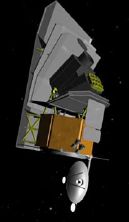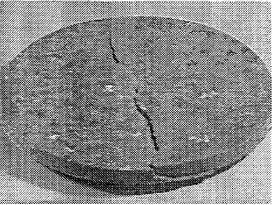“Olemach-Theorem”: Angular-momentum Conservation implies a gravitational-redshift proportional Change of Length, Mass and Charge
Otto E. Rossler
Faculty of Natural Sciences, University of Tubingen, Auf der Morgenstelle 8, 72076 Tubingen, Germany
Abstract
There is a minor revolution going on in general relativity: a “return to the mothers“ – that is, to the “equivalence principle” of Einstein of 1907. Recently the Telemach theorem was described which says that Einstein’s time change T stands not alone (since T, L, M, Ch all change by the same factor or its reciprocal, respectively). Here now, the convergent but trivial-to-derive Olemach theorem is presented. It connects omega (rotation rate), length, mass and charge in a static gravitational field. Angular-momentum conservation alone suffices (plus E = mc² ). The list of implications shows that the “hard core” of general relativity acquires new importance. 5 surprise implications – starting with global constancy of c in general relativity – are pointed out. Young and old physicists are called upon to join in the hunt for the “inevitable fault” in Olemach. (January 31, 2013)
Introduction
“Think simple” is a modern parole (to quote HP). Much as in “ham” radio initiation the “80 meter band playground” is the optimal entry door even if greeted with derision by old hands, so in physics the trivial domain of special relativity’s equivalence principle provides the royal entry portal.
A New Question
The local slowdown of time “downstairs” in gravity is Einstein’s most astounding discovery. It follows from special relativity in the presence of constant acceleration – provided the acceleration covers a vertically extended domain. Einstein’s famous long rocketship with its continually thrusting boosters presents a perennially fertile playground for the mind. This “equivalence principle” [1] was “the happiest thought of my life” as he always claimed.
To date no one doubts any more [2,3] the surprise finding that time is slowed-down downstairs compared to upstairs. The original reason given by Einstein [1] was that all signal sequences sent upwards arrive there with enlarged temporal intervals since the rocketship’s nose has picked up a constant relative departing speed during the finite travel time of the signal from the bottom up. Famous measurements, starting in 1959 and culminating in the daily operation of the Global Positioning System, abundantly confirm Einstein’s seemingly absurd purely mentally deduced prediction. From this hard-won 1907 insight, he would later derive his “general theory of relativity.” The latter remains an intricate edifice up to this day of which not all corners are understood as of yet. For example, many mathematically allowed but unphysical transformations got appended over the years. And a well-paved road running to the right and left of the canonical winded thread is still wanting. For example, the attempt begun by Einstein’s assistant Cornelius Lanczos in 1929 to build a bridge toward Clifford’s older differential-geometric approach [4] remains unconsummated.
In an “impasse-type” situation like this it is sometimes a good strategy to go “back to the mothers” in Goethe’s words, that is, to the early days when everything was still simple and fresh in its unfamiliarity. Do there perhaps exist one or two “direct corollaries” to Einstein’s happiest thought that are likewise bound to remain valid in any later more advanced theory?
A starting point for the hunt is angular-momentum conservation. Angular momentum enjoys an undeservedly low status in general relativity Emmy Noether’s genius notwithstanding. It therefore is a legitimate challenge to be asked to check what happens when angular momentum is “explicitly assumed to be conserved” in Einstein’s long rocketship where all clocks are known to be “tired” in their ticking rate at more downstairs positions in a locally imperceptible fashion. This question appears to be new. In the following, an attempt is made to check how the conservation of angular momentum which is a well-known fact in special relativity manifests itself in the special case of Einstein’s equivalence principle.
Olemach Theorem
To find the answer, a simple thought experiment suggests itself. A frictionless, strictly horizontally rotating bicycle wheel (with its mass ideally concentrated in the rim) is assumed to be suspended at its hub from a rope – so it can be lowered reversibly from the tip to the bottom in our constantly accelerating long rocketship (or else in gravity). Imagine the famous experimentalist Walter Lewin would make this wheel the subject of one of his enlightened M.I.T. lectures distributed on the Internet. The precision of the measurements performed would have to be ideal. What is it that can be predicted?
The law of “angular momentum conservation under planar rotation reads (if a sufficiently slow “nonrelativistic” rotation speed is assumed) according to any textbook like Tipler’s: “angular momentum = rotation rate times mass times radius-squared = constant” or, written in symbols,
J = ω m r² = const. (1)
From the above-quoted paper by Einstein we learn that omega differs across height levels, in a locally imperceptible fashion, being lower downstairs [1]. This is so because a frictionless wheel in planar rotation represents an admissible realization of a “ticking” clock (you can record ticks from a pointer attached to the rim). Then the height-dependent factor which reduces the ticking rate downstairs (explicitly written down by Einstein [1]) can be called K . At the tip, K = 1 , but K > 1 and increasing as one slowly (“adiabatically”) lowers the constantly rotating wheel to a deeper level [1]. Note that K can approach infinity in principle (as when the famous “Rindler rocketship,” with its many independently boosting hollow “rocket rings” that stay together without links, approaches the length of about one light year – if this technical aside is allowed).
The present example is quite refined in its maximum simplicity. What is it that the watching students will learn? If it is true that angular momentum J stays constant despite the fact that the rotation rate ω is reduced downstairs by the Einstein clock slowdown factor K , then necessarily either m or r or both must be altered downstairs besides ω , if J is to stay constant in accordance with Eq.(1).
While infinitely many nonlinear change laws for r and m are envisionable in compensation for the change in ω , the simplest “linear” law keeping angular momentum J unchanged in Eq.(1) reads:
ω’ = ω/K
r’ = r K
m’ = m/K (2)
q’ = q/K .
Here the fourth line was added “for completeness” due to the fact that the local ratio m/q – rest mass-over-charge – is a universal constant in nature in every inertial frame, with a characteristic universal value for every kind of particle. (Note that any particle on the rim can be freshly released into free fall and then retrieved with impunity, so that the universal ratio remains valid.) The unprimed variables on the right refer to the upper-level situation (K = 1) while the primed variables on the left pertain to a given lower floor, with K monotonically increasing toward the bottom as quantitatively indicated by Einstein [1].
How can we understand Eq.(2)? The first line, with ω replaced by the proportional ticking rate t of an ordinary local clock (Einstein’s original result), yields an equivalent law that reads
t’ = t/K ‚ (2a)
with the other three lines of Eq.(2) remaing unchanged. The corresponding 4-liner was described recently under the name “Telemach” (acronym for Time, Length, Mass and Charge). Telemach possessed a fairly complicated derivation [5]. The new law, Eq.(2), has the asset that its validity can be derived directly from Eq.(1).
The prediction made by the conservation law of Eq.(1) is that any change in ω automatically entails a change in r and/or m . There obviously exist infinitely many quantitative ways to ensure the constancy of J in Eq.(1) for our two-dimensionally rotating frictionless wheel. For example, when for the fun of it we keep m constant while letting only r change, the second line of Eq.(2) is bound to read r’ = r K^½ (followed by m’ = m and q’ = q ). Infinitely many other guessed schemes are possible. Eq.(2) has the asset of being “simpler” since all change ratios are linear in K. So the change law does not depend on height; only in this linear way can grotesque consequences like divergent behavior of one variable be avoided.
Now the serious part. We start out with the third line of Eq.(2). We already know from Einstein’s paper [1] that the local photon frequency (and hence the photon mass-energy) scales linearly with 1/K . Photon mass-energy therefore necessarily obeys the third line of Eq.(2). If this is true, we can recall that according to quantum electrodynamics, photons and particles are locally inter-transformable. Einstein would not have disagreed in 1907 already. A famous everyday example known from PET scans is positronium creation and annihilation. In this special case, two 511 kilo-electron-Volt photons turn into – prove equivalent to – one positron plus one electron, in every local frame. Therefore we can be sure that the third line of Eq.(2) indeed represents an indubitable fact in modern physics, a fact which Einstein would have eagerly embraced.
The remaing second line of Eq.(2) could be explained by quantum mechanics as well (as done in ref. [5]). However, this is edundant now since once the third line of Eq.(2) is accepted, the second line is fixed via Eq.(1). The fourth line follows from the third as already stated. Hence we are finished proving the correctness of the new law of Eq.(2).
How to call it? Olemach is a variant of “Oremaq” (which at first sight is a more natural acronym for the law of Eq.(2) in view of its four left-hand sides. But the closeness in content of Eq.(2) to Telemach [4], in which length was termed L and charge termed Ch, lets the matching abbreviation “Olemach” appear more natural.
Discussion
A new fundamental equation in physics was proposed: Eq.(2). The new equation teaches us a new fact about nature: In the accelerating rocket-ship of the young Einstein as well as in general relativity proper under “ordinary conditions” (yet to be specified in detail), angular momentum conservation plays a previously underestimated – new – role.
The most important implication of the law of Eq.(2) no doubt is the fact that the speed of light, c , has become a “global constant” in the equivalence principle. Note that the first two lines of Eq.(2) can be written
T’ = TK
r’ = rK , (2b)
with T = 1/ω and T‘ = 1/ ω‘ . One sees that r’/T’ = r/T . Therefore c-upstairs = c-downstairs = c at all heights (up to the uppermost level of an infinitely long Rindler rocket with c = c-universal at its tip). Thus
c = globally constant. (3)
This result follows from the “linear” structure of Eq.(2). The global constancy of c had been given up explicitly by Einstein in the quoted 1907 paper [1]. (This maximally painful fact was presumably the reason why Einstein could not touch the topic of gravitation again for 4 years until his visiting close friend Ehrenfest helped him re-enter the pond through engulfing him in an irresistible discussion about his rotating-disk problem.) In recompense for the new global constancy of c , it is now m and q that inherit the former underprivileged role of c by being “only locally but not globally constant.” It goes without saying that there are far-reaching tertiary implications (cf. [5]).
The second-most-important point is the already mentioned fact that charge q is no longer conserved in physics in the wake of the fourth line of Eq.(2), after an uninterrupted reign of almost two centuries. This result is the most unbelievable new fact. A first direct physical implication is that the charge of neutron stars needs to be re-calculated in view of the “order-of-unity” gravitational redshift z = K – 1 valid on their surface. Since K thus is almost equal to 2 on this surface, the charge of neutron stars is reduced by a factor of almost 2. Even more strikingly, the electrical properties of quasars (including mini-quasars) are radically altered so that a renewed modeling attempt is mandatory.
Thirdly, a topological new consequence of Eq.(2): “Stretching” is now found added to “curvature” as an equally fundamental differential-geometric feature of nature valid in the equivalence principle and, by implication, in general relativity. Recall that r goes to infinity in parallel with K , in the second line of Eq.(2) when K does so. This new qualitative finding is in accordance with Clifford’s early intuition. While an arbitrarily strong curvature remains valid near the horizon of a black hole where K diverges, the singular curvature is now accompanied by an equally singular (infinite) stretching of r . Thus a novel type of “volume conservation” (more precisely speaking: “conservation of the curvature-over-stretching ratio”) becomes definable in general relativity, in the wake of Eq.(2).
A fourth major consequence is that some traditional historical additions to general relativity cease to hold true if Olemach (or Telemach) is valid. This “tree-trimming” affects previously accepted combinations of general relativity with electrodynamics. In particular, the famous Reissner-Nordström solution loses its physical validity in the wake of Eq.(2). The simple reason: charge is no longer a global invariant. Surprise further implications (like a mandatory unchargedness of black holes) follow. The beautiful mass-ejecting and charge-spitting and electricity and magnetism generating, features of active quasars acquire a radically new interpretation worth to be worked out.
As a fifth point, the mathematically beautiful “Kerr metric” when used as a description of a rotating black hole loses its physical validity by virtue of the second line of Eq.(2). The new infinite distance to the horizon valid from the outside is one reason. More importantly, the effective zero rotation rate at the horizon of a seen from the outside fast-rotating black hole necessitates the formation of a topological “Reeb foliation in space-time” encircling every rotating black hole, as well as (in unfinished form) any of its never quite finished precursors [6].
There appear to be further first-magnitude consequences of the law of angular-momentum conservation (Eq.1), applied in the equivalence principle and its general-relativistic extensions. So the second line of Eq.(2) implies, via the new global constancy of c , that gravitational waves no longer exist [5]. On the other hand, temporal changes of a gravitational potential, for example through the passing-by of a celestial body, do of course remain valid and must somehow be propagated with the speed of light. (This problem is mathematically unsolved in the context of Sudarshan’s “no interaction theorem.”) These two cases can now be confused no longer.
At this point cosmology deserves to be mentioned. The new equal rights of curving and stretching (“Yin and Yang”) suggest that only asymptotically flat solutions remain available in cosmology in the very large – a suggestion already due to Clifford as mentioned [4]. If Olemach implies that a “big bang” (based on a non-volume preserving version of general relativity) is ruled out mathematically, this new fact has tangible consequences. Recently, 24 “ad-hoc assumptions” implicit in the standard model of cosmology were collected [7]. Further new developments in the wake of an improved understanding of the role played by angular-momentum conservation in the equivalence principle, general relativity and cosmology are to be expected.
To conclude, a new big vista opens itself up when the law of angular momentum conservation is indeed valid in the equivalence principle of special relativity of 1907. An inconspicuous “linear law” (Eq.2), re-affirming the role of Einstein’s happiest thought, imposes as the natural “80-meter band” of physics” – or does it not?
Credit Due
The above result goes back to an inconspicuous abstract published in 2003 [8] and a maximally unassuming dissertation written in its wake [9].
Acknowledgment
I thank Ali Sanayei, Frank Kuske and Roland Wais for discussions. For J.O.R.
References
[1] A. Einstein, On the relativity principle and the conclusions drawn from it (in German). Jahrbuch der Radioaktivität 4, 411–462 (1907), p. 458; English translation: http://www.pitt.edu/~jdnorton/teaching/GR&Grav_2007/pdf/Einstein_1907.pdf , p. 306.
[2] M.A. Hohensee, S. Chu, A. Peters and H. Müller, Equivalence principle and gravitational redshift. Phys. Rev. Lett. 106, 151102 (2011). http://prl.aps.org/abstract/PRL/v106/i15/e151102
[3] C. Lämmerzahl, The equivalence principle. MICROSCOPE Colloquium, Paris, September 19, 2011. http://gram.oca.eu/Ressources_doc/EP_Colloquium_2011/2%20C%20Lammerzahl.pdf
[4] C. Lanczos, Space through the Ages: The Evolution of geometric Ideas from Pythagoras to Hilbert and Einstein. New York: Academic Press 1970, p. 222. (Abstract on p. 4 of: http://imamat.oxfordjournals.org/content/6/1/local/back-matter.pdf )
[5] O.E. Rossler, Einstein’s equivalence principle has three further implications besides affecting time: T-L-M-Ch theorem (“Telemach”). African Journal of Mathematics and Computer Science Research 5, 44–47 (2012), http://www.academicjournals.org/ajmcsr/PDF/pdf2012/Feb/9%20Feb/Rossler.pdf
[6] O.E. Rossler, Does the Kerr solution support the new “anchored rotating Reeb foliation” of Fröhlich? (25 January 2012). https://lifeboat.com/blog/2012/01/does-the-kerr-solution-sup…f-frohlich
[7] O.E. Rossler, Cosmos-21: Twenty-four violations of Occam’s razor healed by statistica mechanics. (Submitted.)
[8] H. Kuypers, O.E. Rossler and P. Bosetti, Matterwave-Doppler effect, a new implication of Planck’s formula (in German). Wechselwirkung 25 (No. 120), 26–27 (2003).
[9] H. Kuypers, Atoms in the gravitational field according to the de-Broglie-Schrödinger theory: Heuristic hints at a mass and size change (in German). PhD thesis, submitted to the Chemical and Pharmaceutical Faculty of the University of Tubingen 2005.
———————–




